A study published in the Journal of the Optical Society of America reveals that under identical sun exposure and during the natural aging process, collagen loss in women’s skin occurs at a faster rate than in men’s skin[1]!
Collagen, a crucial protein found in the dermis, acts like a “spring” to maintain skin elasticity. However, as we age, collagen begins to degrade and diminish. This explains why, at a certain age, women are more prone to developing wrinkles, enlarged pores, sagging skin, and other signs of aging.
So why do women age faster than men yet live longer? The latest 2021 World Health Organization report reveals that men in China live 6 years shorter than women.
In truth, aging isn’t just about outward appearance—the real concern lies in the invisible deterioration of cells, tissues, and organs within the body.
While men’s faces may resist aging better, their bodily systems seem more prone to malfunction. Thus, men actually age faster than women. So, what’s behind this?
Many unhealthy lifestyle habits also accelerate aging. Compared to women, men tend to have more detrimental habits, such as drinking, smoking, and poor dietary choices. This is especially true given men’s heavier family responsibilities, greater work pressures, and frequent social drinking engagements. Over time, damage to cellular DNA accumulates in men’s bodies, causing cells to age continuously. This leads to degenerative changes in various systems and organs, including the heart, muscles, and bones.
These factors contribute to the difference in life expectancy between men and women.
Moreover, the most fundamental reason is: Men truly age faster than women! A recent NAD+ whole-blood study reveals that middle-aged and older men age more rapidly. Male NAD+ levels show a significant decline with age.
Given this, how can men slow down aging? How can we reclaim our youthful selves and rediscover our passion?
Middle-aged and older men age faster! The latest NAD+ aging research is here
In March 2022, a Chinese research team published a groundbreaking study titled “Association of Human Whole Blood NAD+ Contents With Aging” in the prestigious journal Frontiers in Endocrinology. The study recruited 1,518 participants aged 18 and above (free of cardiovascular disease or cancer) and measured their whole blood NAD+ levels. Results revealed a distinct gender difference in the trend of NAD+ levels over time. Male NAD+ levels showed a marked decline with age, particularly among middle-aged and older men over 60, who exhibited a significant reduction in NAD+ content [2].
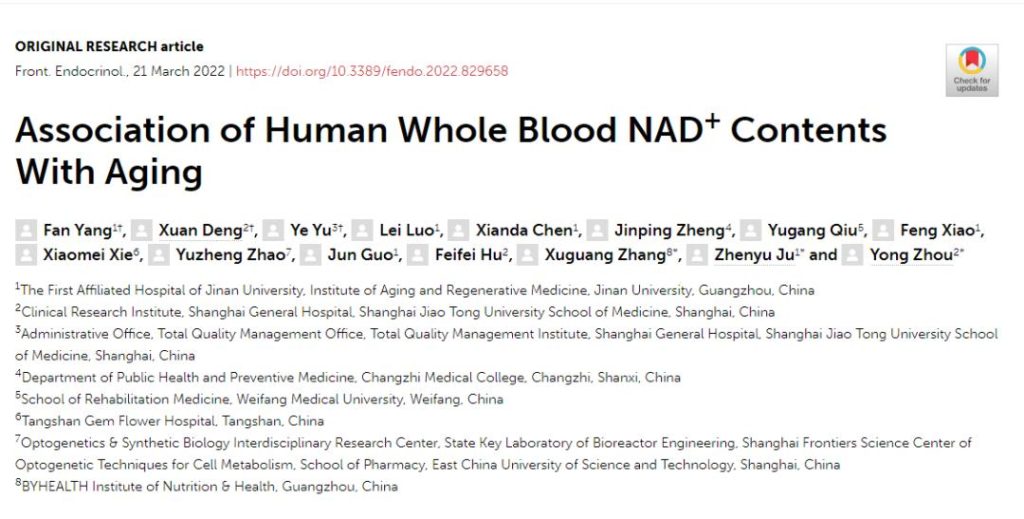
This study was jointly led by the First People’s Hospital affiliated with Shanghai Jiao Tong University School of Medicine and Jinan University, with participation from multiple renowned domestic universities and research institutions. Participants were divided into five age groups: ≤29 years, 30–39 years, 40–49 years, 50–59 years, and ≥60 years, with additional analysis by gender.
Measurements revealed an average whole blood NAD+ level of 33.0±5.5 μmol/L. Gender analysis showed that the average level for males was 34.5±5.4 μmol/L, while females averaged 31.3±5.2 μmol/L, indicating a significantly higher whole blood NAD+ level in males compared to females.

However, NAD+ homeostasis in men seems to be more susceptible to the effects of aging – NAD+ levels decrease significantly with age, especially in middle-aged and elderly men, whose NAD+ content decreases significantly compared to women.
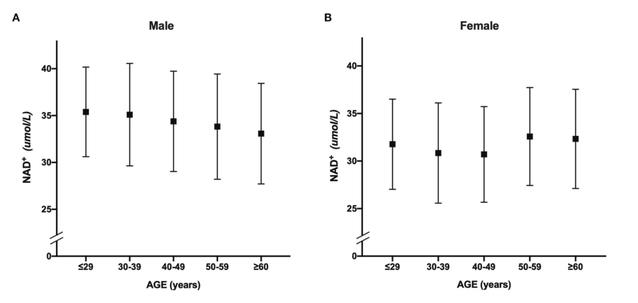
Scientists speculate that this occurs because latent lipid peroxidation and DNA oxidative damage increase in men with age, thereby activating PARP enzymes involved in DNA repair. These enzymes consume large amounts of NAD+ to function, leading to a subsequent decline in NAD+ levels.
Notably, all participants in this NAD+ study were from China, making it the first large-scale study on NAD+ and aging involving Chinese subjects. Compared to foreign literature reports, the trial results can be described as “home-grown and uniquely Chinese,” making them more relevant and valuable for the Chinese population.
Male NAD+ levels exhibit a steep decline, particularly after age 60. Therefore, anti-aging interventions for men should be initiated as early as possible, with precision being key to effectiveness.
What is NAD+, the “King of Anti-Aging”?
As a crucial coenzyme in redox reactions and a participant in numerous biochemical metabolic pathways within organisms, NAD+ plays a crucial role in human health and aging.
NAD+, short for “nicotinamide adenine dinucleotide” and abbreviated as “coenzyme 1,” is a crucial coenzyme present in numerous cellular metabolic reactions within the human body. It participates extensively in numerous fundamental physiological processes within the body, influencing energy metabolism, combating oxidative damage, DNA repair, and regulating genes and genomes that control aging in cells, thereby effectively slowing the aging process.
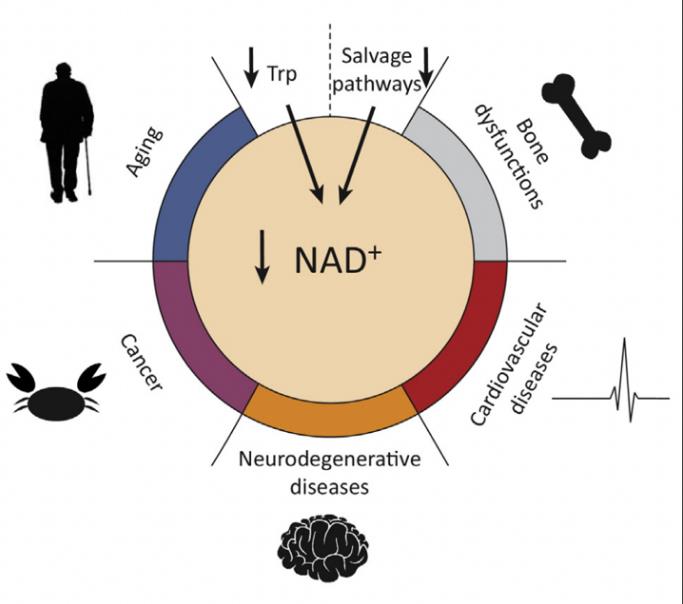
Extensive research indicates that NAD+ participates in thousands of biochemical reactions, including cellular metabolism, oxidative reactions, and protein transcription. Specifically:
1) NAD+ enhances cellular energy levels through the tricarboxylic acid (TCA) cycle pathway;
2) NAD+ activates longevity genes for anti-aging via the Sirtuins pathway;
3) NAD+ repairs DNA through the PARPs pathway;
4) NAD+ slows cellular aging by maintaining chemical communication between the nucleus and mitochondria;
5) NAD+ inhibits lipid peroxidation, protecting mitochondria and cells;
6) NAD+ promotes dopamine production, stimulating muscle growth and helping alleviate Parkinson’s disease symptoms;
7) NAD+ promotes the biosynthesis of norepinephrine and serotonin, alleviating depression and Alzheimer’s disease;
8) NAD+ regulates autoimmune diseases by restoring tissue integrity through modulating immune responses.
…
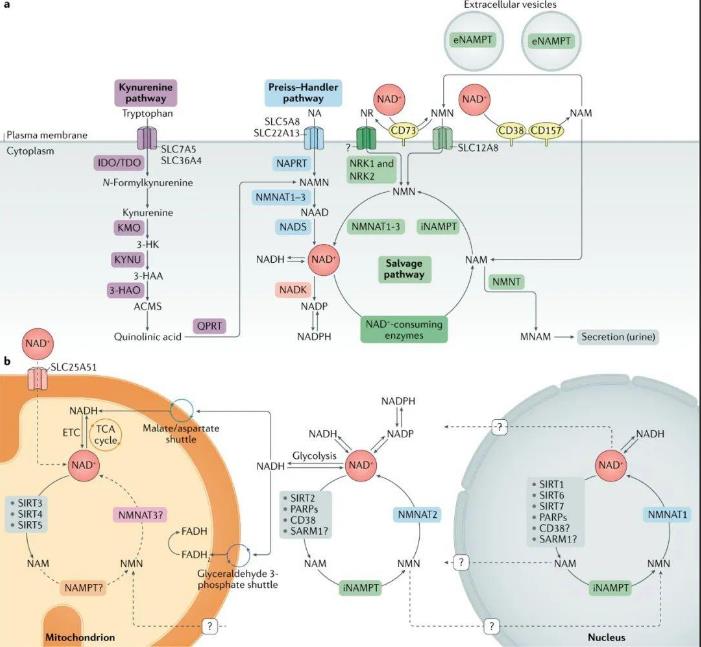
Simply put, NAD+ is essential for maintaining whole-body health and balance. Metabolism, redox, mitochondrial respiration, DNA synthesis and repair, gene stability, epigenetic regulation, etc. all require the participation of NAD+[3][4][5][6][7].
Therefore, our body has a great demand for NAD+. NAD+ is constantly synthesized, decomposed and recycled in cells to maintain a stable cellular NAD+ level.
However, during the aging process, the balance of NAD+ synthesis and decomposition changes, and consumption exceeds production, resulting in a decrease in NAD+ levels in the body.
Hassina Massudi and a team of researchers from the University of New South Wales discovered age-related changes associated with low NAD+ levels. Their research showed that NAD+ levels drop by up to 50% between the ages of 40 and 60, and low levels of NAD+ are associated with many age-related health problems.
Moreover, factors such as stress, poor sleep, lack of healthy nutrition, smoking and alcohol abuse can accelerate this decline. As NAD+ decreases, the body will experience degenerative symptoms such as muscle degeneration, decreased brain power, darker pigmentation, hair loss, etc., which are traditionally called “aging.”
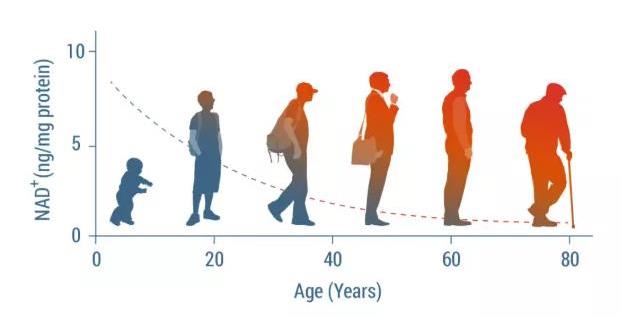
Scientists have discovered that increasing NAD+ levels through external supplementation can help slow aging. Therefore, NAD+ supplements have become a hot product in the anti-aging field. In February 2021, Anthony J. Covarrubias, Rosalba Perrone, and other scholars from the Buck Institute for Research on Aging summarized the scientific literature related to NAD+ and published it in Nature Reviews Molecular Cell Biology, a subsidiary of Nature. The authors pointed out that as we age, NAD+ levels decrease. By directly supplementing absorbable NAD+, we can increase NAD+ levels, which has great benefits for the brain, cardiovascular system, liver, muscles, etc. [8].

Men need more anti-aging and NAD+ supplementation
Overall, the researchers found that aging doesn’t seem to treat men and women equally. Men’s NAD+ homeostasis is more susceptible to aging, with NAD+ levels showing a significant decline with age.
While aging may seem to favor women over men in terms of appearance, at the genetic level, it actually favors men over women.
References:
Journal of the Optical Society of America https://opg.optica.org/josaa/home.cfm
https://doi.org/10.3389/fendo.2022.829658
[3] Imai, S., Armstrong, C. M., Kaeberlein, M. & Guarente, L. Transcriptional
silencing and longevity protein Sir2 is an NAD-dependent histone deacetylase.
Nature 403, 795–800 (2000).
[4] Gomes, A. P. et al. Declining NAD(+) induces a pseudohypoxic state
disrupting nuclear-mitochondrial communication during aging. Cell 155,
1624–1638 (2013).
[5] Verdin, E. NAD(+) in aging, metabolism, and neurodegeneration. Science
350, 1208–1213 (2015).
[6] Camacho-Pereira, J. et al. CD38 dictates age-related NAD decline and
mitochondrial dysfunction through an SIRT3-dependent mechanism. Cell
Metab. 23, 1127–1139 (2016).
[7] Li, J. et al. A conserved NAD(+) binding pocket that regulates protein-protein
interactions during aging. Science 355, 1312–1317 (2017).
[8] Anthony J. Covarrubias, Rosalba Perrone, Alessia Grozio & Eric Verdin.NAD+ metabolism and its roles in cellular processes during ageing.Nature Reviews Molecular Cell Biology.22 December 2020.s41580-020-00313-x.